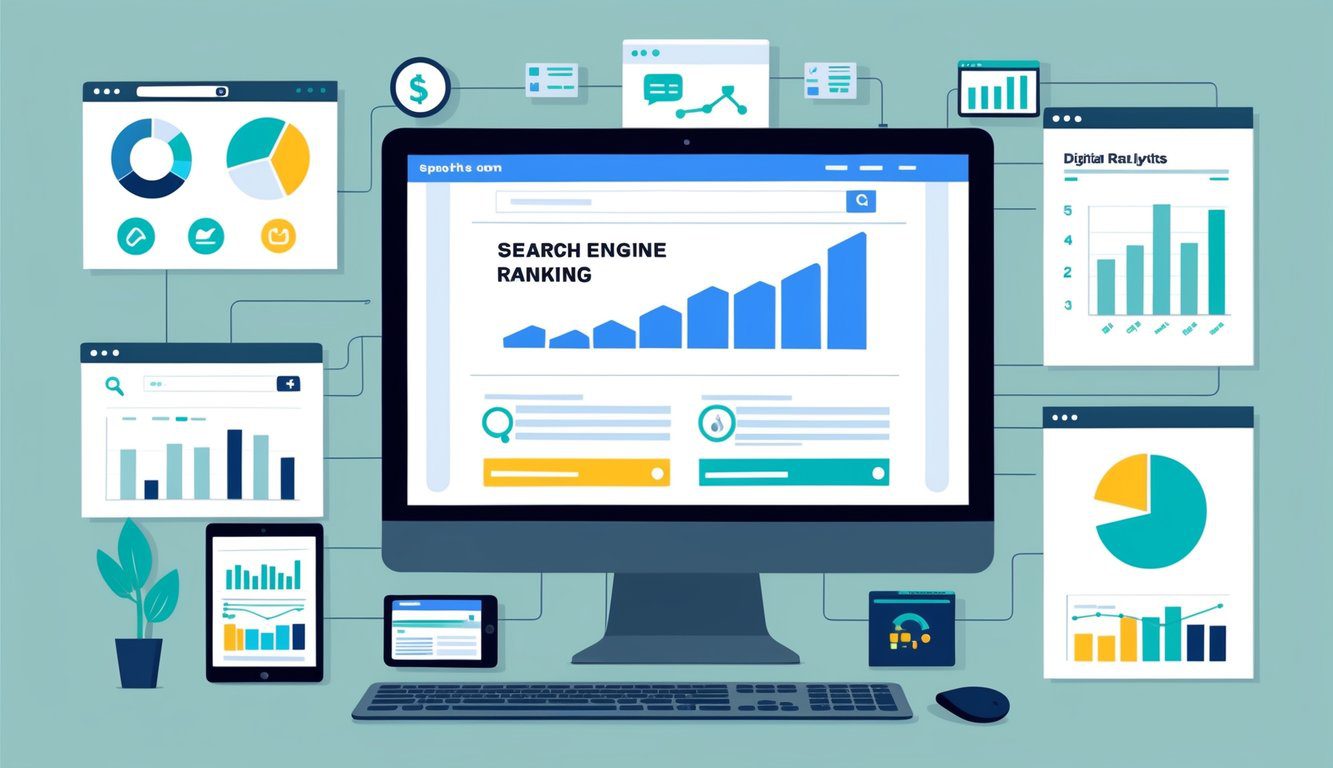Table of Contents
SEO strategy can be a powerful tool for lead generation. By optimizing your website and content for search engines, you can attract more potential customers to your business. A well-executed SEO strategy can significantly boost your lead generation efforts, increasing your website traffic and conversions by up to 14.6%.
SEO for lead generation involves creating high-quality content that addresses your target audience’s needs and questions. This approach helps you rank higher in search results, making it easier for potential leads to find your business. When you focus on targeting keywords with high buying intent, you can attract users who are more likely to become paying customers.
To get the most out of your SEO strategy for lead generation, it’s important to optimize various aspects of your website. This includes improving page load speed, creating informative blog posts, and building quality backlinks. By implementing these techniques, you can improve your website’s visibility and attract more qualified leads to your business.
Key Takeaways
- SEO strategies can significantly increase website traffic and lead generation
- Targeting high-intent keywords helps attract users more likely to convert
- Optimizing website elements like content and speed improves visibility and lead quality
Understanding Lead Generation and SEO
Lead generation and SEO work together to attract potential customers to your business. SEO helps your website appear in search results when people look for products or services like yours. This brings in high-quality leads who are already interested in what you offer.
The Fundamentals of Lead Generation
Lead generation is about finding and attracting potential customers. It’s the process of getting people interested in your business. You want to turn strangers into leads who might buy from you.
There are many ways to generate leads:
- Content marketing
- Social media
- Email campaigns
- Paid advertising
The goal is to collect contact info from interested people. This lets you follow up and try to make a sale. Good lead generation focuses on quality, not just quantity. You want leads who are likely to become customers.
How SEO Complements Lead Generation
SEO helps lead generation by making your website easier to find. When you use SEO, more people see your site in search results. This brings in leads who are looking for what you offer.
SEO improves lead generation in several ways:
- It brings in targeted traffic
- It builds trust and credibility
- It works 24/7 to attract leads
By using keywords your potential customers search for, you connect with them at the right time. SEO also helps you create content that answers their questions. This positions you as an expert they can trust.
The Role of Search Engines in Lead Generation
Search engines are key to finding new leads online. When someone needs a product or service, they often start with a Google search. If your website shows up, you have a chance to turn that person into a lead.
Good SEO practices help you rank higher in search results. This means more people see your site. Search engines look at things like:
- Relevant content
- Website structure
- Loading speed
- Mobile-friendliness
By optimizing for these factors, you improve your chances of appearing in searches. This brings more potential leads to your site. Search engines essentially act as a bridge between you and people who need what you offer.
Implementing SEO Strategies for Lead Generation
SEO can boost lead generation when done right. The key is to focus on your audience, create content they want, and make it easy for search engines to find.
Keyword Research and Target Audience
Start by finding the right keywords. Use tools like Google Keyword Planner or SEMrush to spot terms your audience searches for. Look at search volume and competition.
Think about your ideal customer. What problems do they have? What questions do they ask? This helps you pick keywords that match their needs.
Make a list of main keywords and related terms. Include long-tail keywords – they’re less competitive and show high intent. For example, “best CRM for small business” is better than just “CRM.
Creating Relevant and Engaging Content
Now, create content around your keywords. But don’t just stuff keywords in – focus on quality.
Write blog posts, guides, and case studies that answer your audience’s questions. Use clear, simple language. Break up text with headers, bullet points, and images.
Make your content unique and valuable. Share tips, insights, or data that others don’t have. This helps you stand out and builds trust with potential leads.
Don’t forget to optimize your website pages too. Each page should target a main keyword and cover a specific topic.
Optimizing Content for Search Intent
Search intent is crucial for SEO lead generation. It means understanding why someone is searching.
There are four main types of search intent:
- Informational (wanting to learn)
- Navigational (looking for a specific site)
- Commercial (comparing options)
- Transactional (ready to buy)
Match your content to the right intent. For informational searches, create how-to guides or FAQs. For commercial intent, make comparison pages or product reviews.
Use the right format too. Lists work well for “best of” searches. Step-by-step guides are good for “how to” queries. This helps you rank higher and attract more leads.
Boosting Online Visibility Through SEO
SEO can greatly increase your online visibility and help you attract more leads. By focusing on technical aspects, building quality links, and optimizing your content, you can improve your search rankings and get more eyes on your business.
Technical SEO and Responsive Design
Technical SEO forms the foundation of your online visibility. Make sure your website loads quickly and works well on all devices. A responsive design is key for a good user experience on mobile phones and tablets.
Use these technical SEO tips:
• Improve page speed by compressing images and minifying code
• Create an XML sitemap to help search engines crawl your site
• Fix broken links and redirect errors
• Use HTTPS to secure your site
A fast, mobile-friendly website will keep visitors on your pages longer. This sends positive signals to search engines and can boost your rankings.
Leveraging Link Building and Social Media
Quality backlinks remain a top ranking factor. Focus on getting links from reputable sites in your industry. You can do this by:
• Creating valuable, shareable content
• Reaching out to influencers and industry leaders
• Guest posting on relevant blogs
• Participating in online communities
Social media also plays a role in SEO. While social signals aren’t a direct ranking factor, they can increase your visibility and drive traffic. Share your content on social platforms and engage with your audience to boost your online presence.
Meta Descriptions and SERPs
Your meta descriptions are key for standing out in search results. Write compelling meta descriptions that accurately summarize your page content and include your target keywords. Aim for 150-160 characters to avoid getting cut off in search results.
Tips for effective meta descriptions:
• Include a call-to-action
• Highlight unique selling points
• Match search intent
• Use natural language
Well-crafted meta descriptions can improve your click-through rates from search results. This sends positive signals to search engines and can help boost your rankings over time.
Conversion Rate Optimization and UX
Conversion rate optimization (CRO) and user experience (UX) work together to boost your website’s effectiveness. By focusing on these areas, you can turn more visitors into leads and customers.
Landing Pages and Call to Action
Your landing pages play a key role in CRO. A well-designed landing page can increase your conversion rate significantly. Make sure your pages are clear and focused on a single goal.
Use strong calls to action (CTAs) that stand out. Place your CTAs where users can easily see them. Use action words that urge visitors to take the next step.
Test different versions of your landing pages. Try changing colors, layouts, or wording. This can help you find what works best for your audience.
Keep forms short and simple. Ask only for essential information. The easier you make it for users, the more likely they are to convert.
Pain Points and User Experience
Understanding your users’ pain points is crucial for improving UX. Identify what problems your visitors face and how your product or service can solve them.
Make your website easy to navigate. Users should find what they need quickly. A clear menu structure and search function can help with this.
Page load speed matters. Slow sites can drive users away. Optimize your site’s performance to keep visitors engaged.
Use high-quality images and videos to show your products or services. Visual content can help users understand your offerings better.
Provide clear, helpful information. Answer common questions upfront. This can build trust and make users more likely to convert.
Content Marketing Strategies for SEO
Content marketing is key for SEO-driven lead generation. You need a plan to create valuable content that attracts and engages your target audience. This approach helps boost your search rankings and bring in qualified leads.
Developing a Content Calendar
A content calendar keeps your SEO efforts organized. You should plan topics months in advance. This helps you target seasonal trends and industry events.
Pick themes that match your audience’s interests. Research keywords for each topic. Aim to cover a mix of informational and commercial intent searches.
Set realistic publishing goals. Consistency matters more than volume. Even one high-quality post per week can make a big difference.
Use your calendar to track content types. Mix blog posts, videos, infographics, and ebooks. This variety helps you reach different segments of your audience.
High-Quality Content Creation
Quality trumps quantity in SEO content. Your goal is to provide real value to readers. This builds trust and positions you as an expert.
Focus on in-depth, well-researched pieces. Cover topics thoroughly. Use data, examples, and expert quotes to back up your points.
Make your content easy to read. Use short paragraphs, bullet points, and subheadings. Break up text with relevant images or videos.
Optimize for SEO without sacrificing readability. Include target keywords naturally. Use descriptive titles and meta descriptions.
Remember to link to other relevant content on your site. This helps search engines understand your site structure and keeps readers engaged.
Improving SEO with Technical Tactics
To boost your SEO and generate more leads, focus on technical aspects of your website. These tactics can improve your rankings and attract quality traffic.
Utilizing Headers and Mobile-Friendly Design
Headers play a key role in SEO. Use H1, H2, and H3 tags to structure your content. This helps search engines understand your page layout.
Make your headings clear and descriptive. Include keywords when it makes sense. Don’t stuff keywords unnaturally.
A mobile-friendly design is crucial. More people browse on phones than desktops. Google prioritizes mobile-friendly sites in search results.
Test your site on various devices. Ensure text is readable without zooming. Buttons should be large enough to tap easily.
Page speed matters too. Compress images and minify code to speed up load times. Fast sites rank better and keep visitors engaged.
Guest Blogging and Content Sharing
Guest blogging can boost your SEO and lead generation efforts. Write high-quality posts for respected sites in your industry.
Choose sites with engaged audiences. Your content should provide value to their readers. Include a link back to your site in your author bio.
Share your guest posts on social media. This increases visibility and can drive more traffic to the host site and your own.
Encourage the host site to share your post too. This expands your reach to their audience. It can lead to more organic search traffic for both sites.
Create shareable content on your own site too. Infographics, videos, and in-depth guides often get shared. This can earn you valuable backlinks.
Analyzing SEO and Lead Generation Performance
Tracking your SEO and lead generation efforts is key to success. You need to measure results and make smart changes to get more leads.
Tracking Website Traffic and Lead Quality
To gauge your SEO’s impact on lead generation, you must track website traffic and lead quality. Use Google Analytics to see visitor numbers, pages viewed, and time on site.
Look at which pages bring in the most leads. Check if high-quality traffic turns into sales. Set up goals in Analytics to track form fills, email signups, and purchases.
Watch your sales funnel closely. See where people drop off and try to fix those spots. Compare organic search visitors to paid traffic from SEM and Pay-Per-Click ads.
Using SEO Analytics Tools for Improvement
SEO tools help you spot areas to boost your lead gen efforts. Use rank trackers to see how you’re doing for key search terms. Check if moving up in rankings brings more leads.
Look at on-page factors like title tags, meta descriptions, and content. Tools can show you what to fix to rank higher and get more clicks.
Study your backlink profile. More quality links often mean more authority and leads. Use tools to find link opportunities and track your progress over time.
Integrating SEO into Your Digital Marketing Mix
SEO plays a key role in a well-rounded digital marketing strategy. When combined with other channels, it can boost your lead generation efforts and online visibility.
Email Marketing and SEO Synergy
Email marketing and SEO can work together to improve your lead generation. Use keywords from your SEO strategy in email subject lines and content. This helps keep your messaging consistent across channels.
Create landing pages for email campaigns that are optimized for search engines. These pages can rank for relevant terms and bring in organic traffic.
Use email to promote your best-performing content. This can increase engagement and potentially earn more backlinks, helping your SEO efforts.
Track which email topics get the most clicks. Use this data to guide your content creation for SEO. Popular email topics often make great blog posts or articles that can rank well in search results.
The Balance of Paid and Organic Strategies
Combining SEO with paid advertising can create a powerful lead generation strategy. Use paid ads to target keywords that are hard to rank for organically.
PPC data can inform your SEO efforts. Keywords that perform well in ads may be worth targeting in your organic content.
Use retargeting ads to reach people who have visited your site through organic search. This can help move them further down the sales funnel.
SEO takes time to show results. Paid ads can provide quick traffic while you build up your organic rankings. As your SEO improves, you can adjust your ad spend accordingly.
Building Trust and Credibility Online
Good SEO practices naturally build trust and credibility. Create high-quality, informative content that answers your audience’s questions. This positions you as an expert in your field.
Earn backlinks from reputable sites in your industry. These act as votes of confidence for your content and improve your search rankings.
Optimize for local SEO if you have a physical location. Claim and update your Google My Business listing to improve visibility in local searches.
Focus on user experience. Fast loading times, mobile-friendly design, and easy navigation all contribute to better SEO and a more trustworthy site.
Encourage and respond to customer reviews. Positive reviews can improve your local SEO and build trust with potential leads.
Future-Proofing Your SEO Lead Generation Approach
SEO strategies need to evolve with search engines and user behavior. You can stay ahead by adapting to algorithm updates and focusing on specific buyer needs.
Adapting to Search Engine Algorithm Changes
To keep your SEO strategy future-ready, you must stay informed about search engine updates. Follow trusted SEO news sites and Google’s official blogs.
When changes happen, analyze their impact on your rankings. Adjust your content and technical SEO quickly. This may involve updating meta tags, improving page speed, or enhancing mobile responsiveness.
Consider using AI tools to help predict trends and optimize content. These can give you an edge in understanding search intent and crafting relevant material.
Regular competitive analysis is key. See what top-ranking sites in your industry are doing. This helps you spot new tactics and stay ahead of the curve.
Targeting Long-Tail Keywords and B2B Buyers
Long-tail keywords are vital for attracting qualified B2B leads. These specific phrases often have less competition and higher conversion rates.
Use tools like SEMrush or Ahrefs to find relevant long-tail keywords. Look for terms that show buyer intent, such as “best enterprise CRM software” or “custom manufacturing solutions for aerospace.”
Create detailed content that addresses the specific needs of B2B buyers. This might include in-depth guides, case studies, or comparison articles.
Optimize your content for featured snippets. These can boost visibility and establish your expertise. Use clear headings, bullet points, and concise answers to common questions in your field.
Frequently Asked Questions
SEO plays a key role in generating leads online. It helps businesses get found by potential customers and turn website visitors into qualified leads.
How does SEO contribute to increasing lead generation?
SEO boosts your visibility in search results. This helps more people find your website when looking for products or services you offer. Higher search rankings mean more traffic and more chances to convert visitors into leads.
SEO also improves user experience. A well-optimized site loads faster and is easier to navigate. This keeps visitors on your site longer, increasing the odds they’ll become leads.
What are effective strategies for lead generation through SEO?
Create high-quality content that answers common questions in your industry. This positions you as an expert and builds trust with potential leads.
Use relevant keywords in your content, titles, and meta descriptions. This helps you rank for terms your target audience is searching for.
Optimize your website for mobile devices. Many people search on phones, so a mobile-friendly site is crucial for capturing leads.
What are the costs associated with SEO for lead generation?
SEO costs vary widely based on your goals and resources. You can do some SEO yourself for free, like creating content and optimizing your website.
Hiring an SEO expert or agency will cost more but can bring faster results. Prices range from a few hundred to thousands of dollars per month.
SEO tools and software also have costs. Many offer free versions, while paid plans can range from $50 to $500+ per month.
How does SEO for business growth differ from traditional lead generation?
SEO focuses on attracting people actively searching for your products or services. This often leads to higher-quality leads than traditional methods.
SEO results build over time, unlike paid ads that stop when you stop paying. This makes SEO a more sustainable long-term strategy.
SEO helps you understand your audience better through search data. This insight can improve your overall marketing strategy.
Can SEO significantly increase website traffic and lead potential?
Yes, SEO can greatly boost your website traffic. By ranking higher in search results, you’ll get more clicks and visitors.
More traffic means more potential leads. If your website is optimized to convert visitors, a traffic increase can lead to a significant rise in leads.
SEO also helps you attract more targeted traffic. This means visitors are more likely to be interested in your offerings and become leads.
How do you effectively implement SEO to generate quality leads?
Focus on creating valuable content that addresses your target audience’s needs and questions. This attracts potential leads and builds trust.
Optimize your website for conversions. Use clear calls-to-action and make it easy for visitors to contact you or sign up for offers.
Use local SEO tactics if you serve a specific area. This helps you attract high-quality local leads.
Track your results and adjust your strategy as needed. SEO is an ongoing process, so continual improvement is key to generating quality leads.









